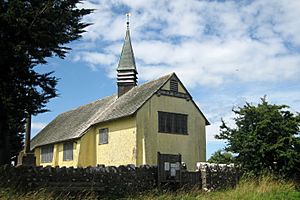Church of St Hugh, Charterhouse facts for kids
Quick facts for kids Church of St Hugh |
|
|---|---|
 |
|
| Location | Charterhouse, Somerset, England |
| Built | 1908 |
|
Listed Building – Grade II*
|
|
| Designated | 9 February 1961 |
| Reference no. | 1307304 |
| Lua error in Module:Location_map at line 420: attempt to index field 'wikibase' (a nil value). | |
The Church of St Hugh is a beautiful old church located in a place called Charterhouse in Somerset, England. It was built in 1908 and is considered a very important historical building, known as a Grade II* listed building. This means it's protected because of its special history and architecture.
A Special Church in Somerset
How the Church Began
The Church of St Hugh is named after a famous saint, Hugh of Lincoln. It was built in 1908 by an architect named W. D. Caröe. The idea for the church came from a local leader, Reverend Menzies Lambrick. What's really interesting is that this church used to be a welfare hall for the people who worked in the local lead mines. It was a place where miners could gather and find support.
Inside the Church
The inside of the Church of St Hugh has many special features. The roof, a screen, a large cross (called a rood), and the altar are all made from carved, whitened oak wood. The church also has beautiful decorations and fittings that are in the Arts and Crafts style. This style was popular around the time the church was built and focused on handmade items and traditional craftsmanship.
The walls of the church are made of rough brick, and it has a tiled roof. One of the most striking parts of the church is its stained glass window. This window was created by an artist named Horace Wilkinson and shows the nativity scene, which is the story of Jesus's birth.
Other Important Parts
The church isn't the only part of the site that is protected. A cross in the churchyard, which is the area around the church, and the churchyard wall itself are also considered listed buildings. This means they are also important historical structures that need to be preserved.

